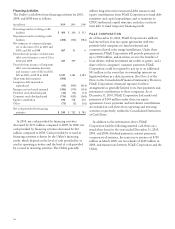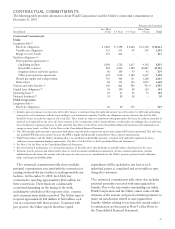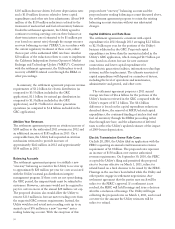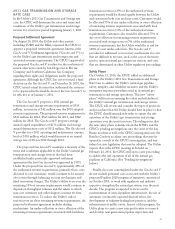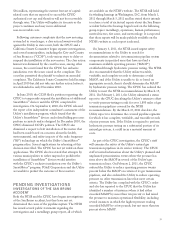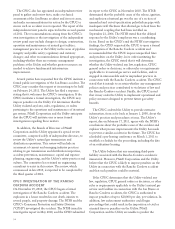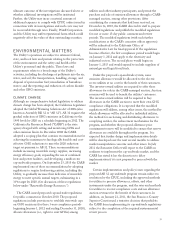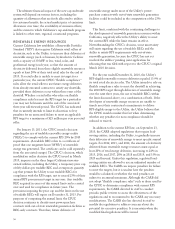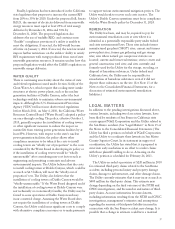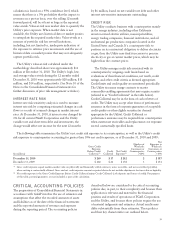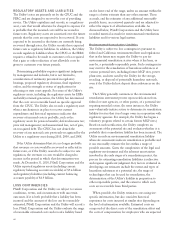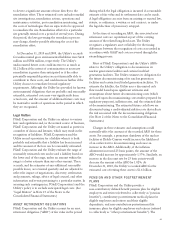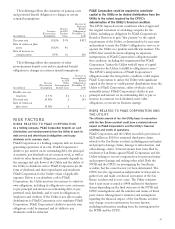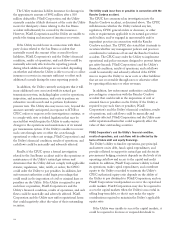PG&E 2010 Annual Report Download - page 39
Download and view the complete annual report
Please find page 39 of the 2010 PG&E annual report below. You can navigate through the pages in the report by either clicking on the pages listed below, or by using the keyword search tool below to find specific information within the annual report.ultimate outcome of the investigations discussed above or
whether additional investigations will be instituted.
Further, the Utility may incur a material amount of
additional expenses to comply with CPUC orders issued in
connection with its investigations and such costs may not
be recoverable through rates. Finally, PG&E Corporation
and the Utility may suffer reputational harm which could
negatively affect the value of their outstanding securities.
ENVIRONMENTAL MATTERS
The Utility’s operations are subject to extensive federal,
state, and local laws and permits relating to the protection
of the environment and the safety and health of the
Utility’s personnel and the public. These laws and
requirements relate to a broad range of the Utility’s
activities, including the discharge of pollutants into the air,
water, and soil; the transportation, handling, storage, and
disposal of spent nuclear fuel; remediation of hazardous
wastes; and the reporting and reduction of carbon dioxide
and other GHG emissions.
CLIMATE CHANGE
Although no comprehensive federal legislation to address
climate change has been adopted, the California Legislature
adopted the Global Warming Solutions Act of 2006 (also
known as Assembly Bill 32 or “AB 32”). AB 32 requires the
gradual reduction of GHG emissions in California to the
1990 levels by 2020 on a schedule beginning in 2012. The
California Air Resources Board (“CARB”) is the state
agency charged with setting and monitoring GHG and
other emission limits. In December 2008 the CARB
adopted a scoping plan that contains recommendations for
achieving the maximum technologically feasible and cost-
effective GHG reductions to meet the 2020 reduction
target set pursuant to AB 32. These recommendations
include increasing renewable energy supplies, increasing
energy efficiency goals, expanding the use of combined
heat and power facilities, and developing a multi-sector
cap-and-trade program. On September 23, 2010 the CARB
implemented one of these recommendations by adopting
regulations to require load-serving entities, including the
Utility, to gradually increase their deliveries of renewable
energy to meet specific annual targets, culminating in a
33% target by 2020. (See discussion of these regulations
below under “Renewable Energy Resources.”)
The CARB issued proposed cap-and-trade regulations
for public comment in October 2010. The proposed
regulations include provisions to establish state-wide caps
on GHG emissions (for three 3-year compliance periods
beginning January 1, 2012 and ending December 31, 2020),
allocate allowances (i.e., rights to emit GHGs) among
utilities and other industry participants, and permit the
purchase and sale of emission allowances through a CARB-
managed auction, among other provisions. After
considering the comments that had been received, on
December 16, 2010, the CARB directed its staff to prepare
modified regulations and publish the modified regulations
for one or more 15-day public comment and review
periods. The modified regulations (with such further
modifications as the CARB’s executive officer approves)
will be submitted to the California Office of
Administrative Law for final approval. If the regulations
become effective, the first compliance period would begin
on January 1, 2012 and apply to the electricity and
industrial sectors. The second phase would begin on
January 1, 2015 and would expand to include suppliers of
natural gas and liquid fossil fuels.
Under the proposed cap-and-trade system, some
emission allowances would be allocated to the electric
sector utilities at no cost for the benefit of their customers.
The investor-owned utilities are required to offer these
allowances for sale in the CARB-managed auction. Auction
revenues will be used to benefit the utilities’ customers.
The investor-owned utilities will be required to buy
allowances in the CARB auction to meet their own GHG
compliance obligations. It is expected that the modified
regulations will address, among other issues, the method by
which allowances will be allocated to individual utilities,
the method for auctioning and distributing allowances to
complying entities, the enforcement mechanisms for the
program, and whether the proposed allowance price
containment reserve will be modified to ensure that reserve
allowances are available throughout the program. It is
expected that further design and implementation details
will be developed over the next several months to address
market manipulation concerns and other issues. In July
2011 the Executive Officer will report to the CARB on
readiness to implement the cap-and-trade market, and the
CARB has stated it has the discretion to delay
implementation if it is not prepared to proceed with the
market.
Certain implementation and policy issues regarding the
proposed AB 32 cap-and-trade program remain subject to
resolution by the CPUC, including the approved methods
for utilities to procure allowances, offsets, and other
instruments under the program, and the rates and methods
for utilities to recover compliance costs and use allowance
auction revenues for the benefit of their customers. In
addition, on January 21, 2011, the San Francisco County
Superior Court issued a tentative decision that prohibits
the CARB from implementing its cap-and-trade regulations
subject to the completion of the required environmental
review process.
35



